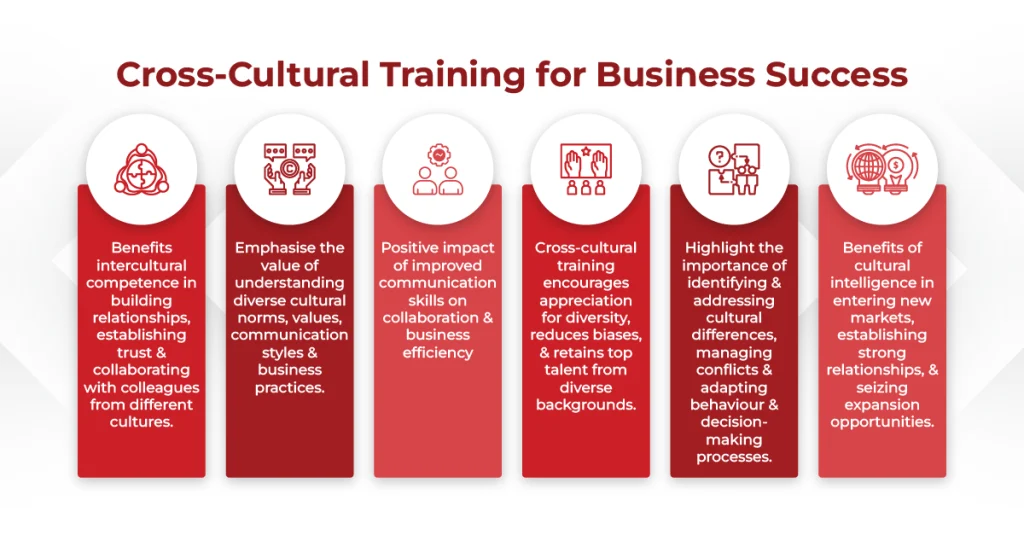Your global team is on the verge of sealing a million-dollar deal. The client on the other side of the world nods politely during the final call with Cross-cultural communication. You read it as a “yes.” They meant it as “I hear you.” Weeks later, the contract falls through—not because of bad strategy, but because of a misread cultural cue.
This kind of slip happens more often than we think. In fact, miscommunication costs U.S. businesses an estimated $1.2 trillion every year, and large companies lose on average $62.4 million annually to poor internal communication.
With the right tools—like learning to spot high-context vs. low-context cues, or training teams to check their unconscious bias—you can transform potential pitfalls into moments of trust and clarity. And that’s exactly what this post is about: practical cross-cultural communication skills that global teams can start using today.
Why Cross-Cultural Communication Matters for Business Growth
The way you communicate can either build bridges that drive loyalty and revenue… or quietly chip away at trust and opportunity.
Here’s where cross-cultural communication becomes more than just a “soft skill.” It’s the difference between growth and missed chances:
Remote work means more cross-cultural conversations than ever.
With hybrid and virtual cross-cultural meetings here to stay, leaders are running meetings with colleagues logging in from Cairo, Berlin, and Tokyo—all in the same hour. In the U.S. alone, nearly 22.8% of employees now work remotely at least part-time, which adds up to more than 36 million people dialing in from different corners of the country. Globally, that figure rises to almost 28% of workers.
Customer loyalty is built on language—and lost without it.
When customers reach out, they want to feel understood. A global survey found that 74% of consumers are more likely to repurchase from a brand that offers multilingual customer support, while 40% won’t buy at all if your website doesn’t speak to them.
Localized marketing turns good ROI into great ROI.
Digital marketing already delivers jaw-dropping returns—email campaigns average an ROI of 3,600%, while SEO sits around 2,200%. But those numbers only climb when campaigns actually resonate. Swap generic translations for thoughtful international marketing adaptation, and suddenly your message lands.
Cultural Value Dimensions You Can’t Ignore
Cross-cultural communication rules can mean the difference between a deal that moves forward and one that quietly stalls. Let’s look at three dimensions that every global leader should have on their radar:
High-Context vs. Low-Context
Ever been caught off guard by how vague someone’s response seemed—or how blunt another’s felt? That’s the high- vs. low-context divide at work. In high-context cultures (like Japan or China), communication is dense with nuance.
Meaning often lives between the lines—tone, pauses, even silence can be part of the message. In low-context cultures (like the U.S. or Germany), communication tends to be explicit, leaving little room for interpretation.
Individualism vs. Collectivism & Power Distance
Feedback is another area where cultural values collide. In individualistic cultures (like the U.S. or Australia), people expect direct feedback and often see it as a sign of respect. Hofstede’s research backs this up: the U.S. scores a striking 91 on individualism. In contrast, more collectivist cultures like Malaysia score as low as 25, where harmony and group cohesion often outweigh personal opinion.
Layer onto that the idea of power distance norms—how comfortable people are with hierarchy. In high power-distance cultures, questioning a manager can feel inappropriate, even risky.
Uncertainty Avoidance
Some cultures embrace flexibility—“We’ll figure it out as we go.” Others find that deeply unsettling. Belgium, for example, scores 94 on Hofstede’s uncertainty avoidance strategies, meaning teams there tend to prefer rules, detailed planning, and clear contingencies.
So, if you launch a project kickoff saying, “Let’s keep it flexible,” that might sound energizing to an American team—but stressful to a Belgian one. Instead, offering scenario-based plans can create trust and calm nerves.
Reading the Room: Verbal & Non-Verbal Signals
Ever been in a meeting and felt like you were in the wrong movie—even though everyone seemed nodding along? That’s the magic (or the trap) of non-verbal cues.
Let’s talk about what really happens beneath the words:
Indirect Communication vs Frank Speech
Some cultures lean into the art of hinting. Nods, silence, “uh-huhs”—those mean something important. In others, people bundle clarity, honesty, and directness into a single sentence.
Mixing these styles without awareness can lead to misreads. A polite “maybe” might actually mean “no,” and what sounds like honesty might feel like harshness.
Silence in Negotiation: Pause Length by Region
Silence isn’t always awkward. In fact, MIT Sloan research shows that pauses of around 3 seconds—what they call silence in negotiation—often lead to breakthroughs in negotiations.
In some cultures, that stillness is comfortable and welcome; in others, especially those less accustomed to silence (think certain Western cultures), it can feel like a vacuum begging to be filled. A little awareness—and strategic pausing—can turn silence into your secret strength.
Eye Contact & Gesture Interpretation
Eyes, gestures, and even head tilts say more than words sometimes. For instance:
| U.S., U.K., Western Europe | Engaged, confident, sincere—looked for during conversation |
| East Asia (e.g. Japan) | More modest or respectful—sustained gaze can feel aggressive |
| Latin America | Brief, warm eye contact—sustained gaze may feel confrontational |
That’s why noticing and respecting local cues is the only path to truly effective, frictionless global communication.
Ever wondered where localization vs internationalization actually differ? Read the full story.
Building Intercultural Competence
Here we move from theory to real-world action! This is where practical steps marry insight to habit—and where you become the kind of leader everyone wants on their global team.
Boost Your Cultural Intelligence (CQ)
Think of CQ as your cultural “sixth sense”—an ability to pause, reflect, and adapt when cultures collide. The model, introduced by Earley and Ang, breaks it down into four parts:
- Metacognitive CQ: How you reflect, step back, and adjust your thinking when things get culturally messy.
- Cognitive CQ: What you know about other norms, values, and customs.
- Motivational CQ: That spark inside you saying, “I really want to connect across cultures.”
- Behavioral CQ: How gracefully you shift your style—from tone to timing—so your message lands.
Empathy Across Cultures & Active Listening
Ever feel heard—and truly seen—when someone mirrors what you say? That simple act—mirror‑summaries, paraphrasing, tuning tone—is empathy across cultures.
76% of executives rate empathy as essential to leadership success. And when managers lead with empathy, trust rises, collaboration deepens, and effectiveness goes up across continents.
Need interpreting services that feel like second nature? Let’s talk.
Bias Awareness Training & Stereotype Mitigation
We all carry biases—those mental shortcuts built up over time. The goal is awareness. Many organizations use micro-learning modules—short, focused sessions—to surface and shift biases over time, rather than overwhelm with a one-off lecture.
Pair that with pulse surveys—regular, small-scale check-ins—and you can watch what shifts over time: are your teams talking more openly? Are fewer misunderstandings bubbling up? It’s both subtle and measurable.
Companies investing in cross-cultural training can see up to 30% gains in team performance—and often enjoy smoother interactions and stronger cohesion across every time zone.
From reading subtle pauses in negotiation to designing feedback loops that respect hierarchy, the leaders who get this right unlock growth that spreadsheets alone can’t deliver.
However, no leader should have to decode all of this alone. For more than a decade, AsiaLocalize has been helping global businesses bridge the gap—making messages land naturally in over 120 languages, and ensuring every cultural nuance works for you.
Let’s make brand localization your growth superpower.







